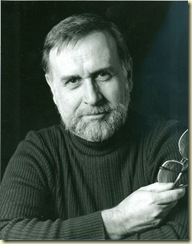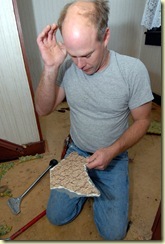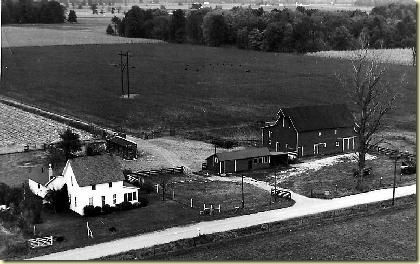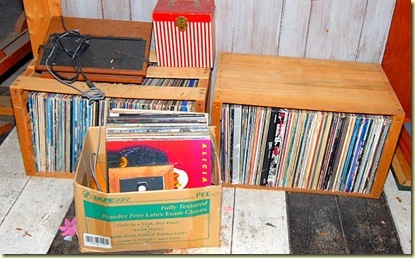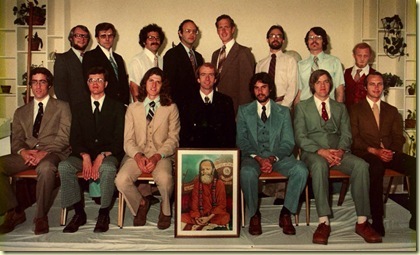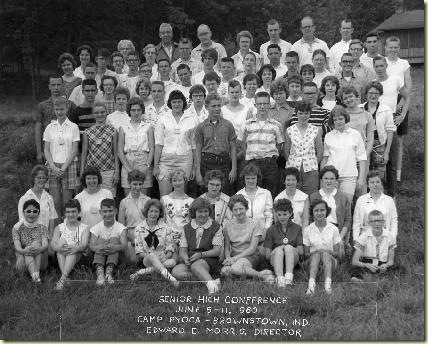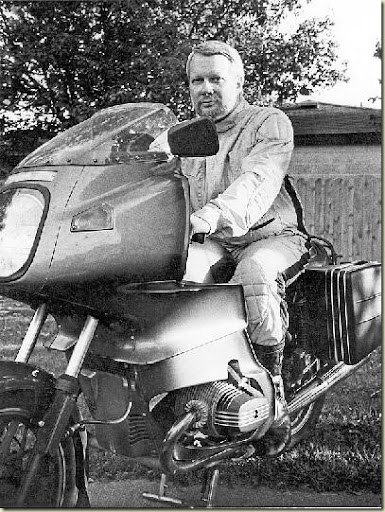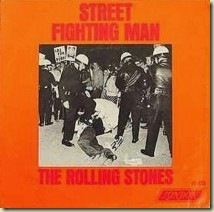Today is the seventh anniversary of the day I walked away from my job as education reporter in the Metro North Bureau of The Indianapolis Star.
I hated The Star, mostly because it survived at the expense of the paper I gave my working life to - The Indianapolis News.
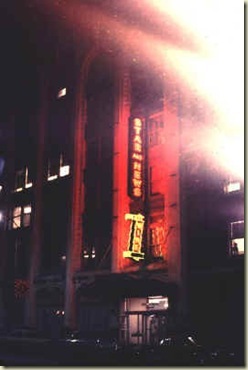 I started at The News on Feb. 6, 1967 and remained a Newsie through the staff merger with the sister paper, The Star, in 1995 and until the bean counters killed The News on Oct. 1, 1999.
I started at The News on Feb. 6, 1967 and remained a Newsie through the staff merger with the sister paper, The Star, in 1995 and until the bean counters killed The News on Oct. 1, 1999.
The News was an evening paper and had all of the demographics and trends working against it. We had a smaller staff and a smaller budget than The Star, yet we routinely beat them to stories. When they got there first, we did it so well the next day that people forgot where they'd seen it first.
We liked to tell ourselves that we were, reporter for reporter, editor for editor and photographer for photographer, better than our counterparts at The Star. When the staffs were merged in '95 and we found ourselves working alongside The Star people, we were startled to discover - with a few notable exceptions - how right we had been to feel superior.
I started my career at The News on the City Desk as a rewrite man, that is I spent my mornings taking information from our police reporters and turning it into coherent stories. The rest of the day was spent rewriting press releases, working on news stories or feature stories. Later, I spent a couple of years as a makeup editor, often laying out all of the inside pages of the paper, then supervising the printers in the composing room as they assembled the pages. This was in the days of typewriters and linotype machines. That's pre-computer to you pups. I was in the last generation of newspaper people to work with what came to be called hot type. Computer generated newspapering with offset printing is called cold type.
I returned to the city room to join the staff of the State Desk, which meant I covered anything outside of Marion County, in which Indianapolis is situated. As suburbia advanced into the surrounding counties, the paper's focus shifted to covering issues in those counties and the State Desk became the State-Suburban Desk. Then, in 1985, Managing Editor Frank Caperton decided we should further exploit the suburban market by creating special zoned editions - special sections devoted to the counties to the north, west and south. That meant the creation of three one-man bureaus. It came at a time when an arrogant twit had weaseled his way into power in the city room and seemed hell-bent on making a lot of good people miserable. Being on the State-Suburban Desk, I was out of his direct line of command, but it was still disturbing enough to motivate me to apply for the North Bureau chief position. I spent the next 10 years developing sources, cultivating a cadre of correspondents and covering events in Boone and Hamilton counties.
When the decision was made to merge the staffs of The News and The Star, I got folded into an expanded bureau as education writer. The papers went through a series of leadership changes, requiring many of us to reapply for our jobs multiple times - always a morale-building technique.
Then, in January, 1999, Publisher Eugene S. Pulliam died at the age of 84. Gene Jr., as we called him - his father was Eugene C. Pulliam, one of the founders of Sigma Delta Chi, the Society of Professional Journalists - grew up with The News. As a boy, he was an Indianapolis News carrier in Lebanon, Ind. He vowed The News would not be sold or closed while he lived. It only took the bean counters eight months to kill The News once Gene Jr. was gone.
Next came another round of management reshuffling against a background of greedy scrambling by Pulliam heirs to sell off what was left of the life work of Gene Jr. and his dad. I was already wanting out by the time it was announced the paper was being sold to Gannett.
It didn't take long for Gannett's management-by-fear style to suck the last remaining fun out of my job.
So when my mother died on Oct. 5, 2000, she gave me the golden parachute I needed. The day after her funeral, I read her will, consulted with my attorney and concluded I didn't have to do this anymore.
The next day - Oct. 11, 2000 - as I was driving to work, I called Maria on the cell phone and told her I was thinking about quitting.
"I dare you," she said.
So when I got to the office, I sat down at my desk, called Human Resources and told them to cash me in, I was done, as of today.
I asked the woman if I would suffer any consequences of not giving two weeks' notice.
"Do ever expect to need a job recommendation from us?" she asked.
After I stopped laughing, I assured her that I was confident that a 34-year career would speak for itself.
She noted that I had turned 55 a few months earlier and was eligible for early retirement with a reduced pension. OK, so I'm retiring.
Now, seven years later, I'm still waiting for the panic attack that never came. It was one of the most liberating experiences of my life and I suspect my example helped a few others make the jump as well.
Back in October, 1999, we held a wake for The News at the Fourth Estate, a huge recreational facility the Pulliams had created for News and Star employees and their families on the northeastside of Indianapolis. (Naturally, Gannett closed it and sold the land to developers.)
Here are some photos from that evening:
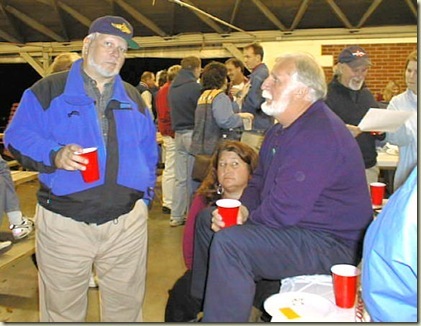
Here I am with longtime friend and Newsie Skip Hess.
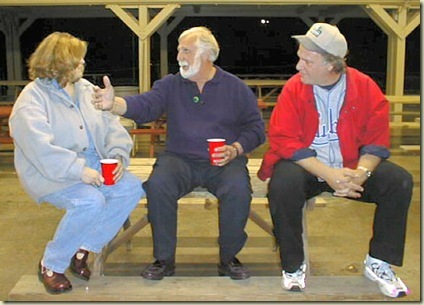
Maria with Skip and author/columnist/raconteur/musician Mike Redmond.
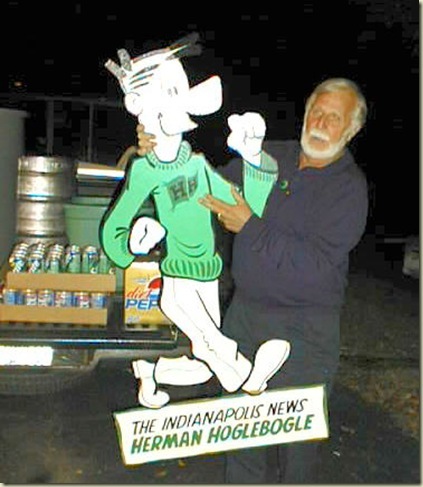
Skip with The News' mascot Herman Hoglebogle.
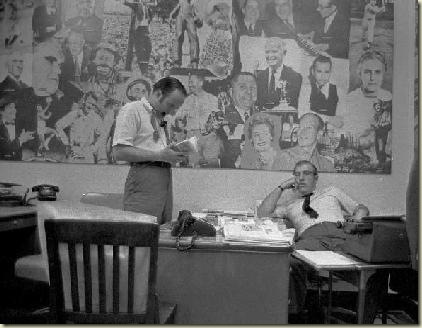 As fate would have it, this photo collage mural of famous Hoosiers in the old News City Room, followed me to Thorntown. Gerry LaFollette (left), bought it at an auction of Indianapolis Press Club furnishings and donated it to the Thorntown Public Library. Gerry's family was from the Thorntown area. The guy on the right is Bill "Moose" Roberts who, like me, came to The News from the Tipton Tribune.
As fate would have it, this photo collage mural of famous Hoosiers in the old News City Room, followed me to Thorntown. Gerry LaFollette (left), bought it at an auction of Indianapolis Press Club furnishings and donated it to the Thorntown Public Library. Gerry's family was from the Thorntown area. The guy on the right is Bill "Moose" Roberts who, like me, came to The News from the Tipton Tribune.




